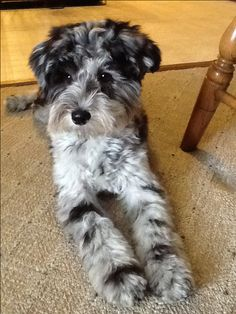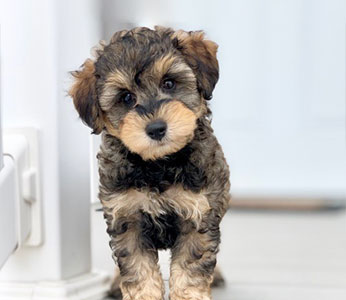Mini Schnoodle Breed Information


The Mini Schnoodle - a mix between the Miniature Schnauzer and Miniature Poodle - is one of the cutest and most playful designer dogs. Mini Schnoodles are smart, outgoing, and have very low-shedding coats, which makes them one of the most popular family-friendly dogs for people who require a hypoallergenic dog. Weighing between 10 to 20 pounds and standing about 12-15 inches tall, these dogs are great for apartment living and homes that have small yards.
Mini Schnoodles are one of those designer breeds that have inherited the most fantastic qualities from their parents. From the Schnauzer side of the family, they inherit their playful and alert personalities. They have an upbeat disposition that makes them fun to be around. The Poodle contributes its high intelligence and great trainability, which means they are fantastic at learning new tricks. Mini Schnoodle dogs adapt easily to various living conditions and love being with their humans 24/7.
One of the important features of the Mini Schnoodle breed is their curly or wavy coat, which sheds very little. This breed is a good companion pet for people with allergies. Schnoodles require regular grooming, which includes brushing a few times a week and professional grooming every 4-6 weeks to maintain the health of the coat and prevent matting.
Characteristics
- Smart and Easy to Train: Mini Schnoodles are highly intelligent, as both their parents-the Miniature Schnauzer and Poodle-are rated as smart dog breeds.
- Hypoallergenic: Thanks to their Poodle parent, Mini Schnoodles are very low shedders with curly or wavey coats.
- Playful and energetic: Even though the Mini Schnoodle is small, it still needs daily exercise of 30-60 minutes. These mini dogs enjoy walks, playtime activities, and mental stimulation in the form of toy puzzles or interactive games.
- Family-oriented: Mini Schnoodles have a great level of affectionate friendliness. They make for excellent family dogs for those with children, singles, or seniors. They are attached to their family and enjoy interacting with other pets and children.
- Adaptable and Versatile: Mini Schnoodles can adapt easily to a variety of living situations – from apartments to houses, with or without yards. Their small size and moderate energy levels make them well-suited for urban living, so long as they get enough exercise.
- Hybrid Vigor: Mini Schnoodles, like most crossbreeds, can benefit from improved health thanks to hybrid vigor. More often than not, hybrids like the Miniature Schnoodle have a more diverse gene pool and can be healthier than the parent breeds.

Appearance
The Mini Schnoodle is an interesting designer breed with a beautiful combination of features inherited from both its parents. This hybrid breed inherits a curly or wavy coat that may vary in texture from soft and fine, as found in Poodles, to the somewhat coarser coat of the Schnauzer. The coat is low-shedding and hypoallergenic, which makes the Mini Schnoodle a popular choice for people with allergies.
Mini Schnoodles come in a variety of colors. Common colors include black, white, grey, apricot, merle, and even parti-color- two or more distinct colors. Their size varies depending on the size of the parents, but the average weight of a Mini Schnoodle is between 10 to 20 pounds with a height of 12 to 15 inches at the shoulder. Primarily bred as a small dog, the three sizes of the Schnoodle are Toy, Miniature, and Standard.
Mini Schnoodle dogs have expressive, dark eyes and a lively, alert expression, reflecting their intelligent and curious nature. Their ears can be erect or fairly floppy, depending on which parent the Mini Schnoodle favors.
Temperament
The Mini Schnoodle is very affectionate and social, being a very friendliness-oriented canine by nature. Mini Schnoodle dogs thrive on human interaction and love being part of the family. This makes them perfect companions for families, singles, and seniors alike. They get along well with children and other pets, too, which makes them quite versatile. Their outgoing nature means they are always ready to greet visitors or go for an adventure in the dog park. They're also quite happy to snuggle up on the couch for some quiet time with their favorite humans.
When it comes to intelligence, the Mini Schnauzer truly shines. As the Miniature Poodle and Miniature Schnauzer are considered among the most intelligent dog breeds, their offspring can’t be anything but smart. This high intelligence makes them easy to train since they pick up commands quickly, and they are usually very good at activities such as obedience training and agility. However, their keen intelligence means that they need very frequent mental stimulation to avoid boredom that may, at times, result in mischief.
One thing to consider with the Mini Schnoodle is the issue of barking. Though they are not known to be overly loud, they do have a protective instinct inherited from the Schnauzer side. This can make them alert barkers, especially when they notice something unfamiliar. They will let you know when someone is at the door. This makes them great for those in search of a watchdog. However, proper training can control their barking effectively.
Care
Grooming
Basic grooming is a must for a Mini Schnoodle; this prevents tangles, mats, and also ensures the health of the coat. The occasional brushing- a few times a week, helps to remove loose hair and prevent tangling.
Professional grooming is also necessary every 4-6 weeks to keep the coat trimmed and neat. Popular haircuts for Mini Schnoodles are the teddy bear cut and the lamb trim; these prevent the fur from getting too long and make maintenance easier.
Due to their floppy ears, Mini Schnoodles can be prone to ear infections. Regular checking and cleaning of their ears will prevent any type of moisture accumulation that may lead to infections. Regular dental care is also important, as small dog breeds like the Mini Schnoodle tend to be susceptible to dental challenges. This can be done by brushing their teeth several times a week to reduce plaque build-up.
Exercise Needs
Mini Schnoodles are working dogs that enjoy regular exercise to stay happy and healthy. Generally, a Mini Schnoodle needs 30-60 minutes of daily exercise divided into walks, playtime, and some interactive games.
These dogs love to engage in activities like brisk walks, fetch, and mental exercises such as puzzle toys. Due to their intelligence, they benefit from games that challenge their minds, like hide-and-seek or agility training, which help prevent boredom and destructive behaviors. Without enough exercise and mental stimulation, a Mini Schnoodle may develop behavior issues, including restlessness or excessive barking.
Health
The Mini Schnoodle is generally a healthy breed that benefits from the hybrid vigor of its purebred Miniature Schnauzer and Miniature Poodle parents. However, like all breeds, they can be prone to certain common health issues, so regular veterinary checkups and preventative care are important to ensure their well-being.
One of the most frequent concerns in Mini Schnoodles is allergies, which can manifest as skin irritations, itching, or excessive licking. Keeping their environment clean and feeding them a high-quality diet can help reduce allergic reactions.
Another common issue seen in Mini Schnoodles is ear infections, particularly because of their floppy ears, which can trap moisture and lead to bacterial growth. Regular ear cleaning is recommended to prevent infections.
Lifespan
The Mini Schnoodle has a relatively long lifespan for a small dog breed, typically living between 12 to 16 years. This longevity is partly due to their mixed-breed heritage, which often leads to better overall health compared to some purebred dogs, a phenomenon known as hybrid vigor.
To ensure your Mini Schnoodle enjoys a full, healthy life, it’s important to focus on preventive care. Regular veterinary checkups, a balanced diet, and consistent exercise are key factors in maintaining their health throughout their life. Because they are an active breed, providing daily exercise and mental stimulation helps keep them physically fit and mentally sharp, which can contribute to a longer lifespan.
Training
The Mini Schnoodle is highly trainable due to its intelligence and eagerness to please, traits inherited from both the Miniature Poodle and Miniature Schnauzer. These dogs are quick learners and respond well to positive reinforcement methods, such as treats, praise, and play. Their sharp minds make them ideal candidates for obedience training and more advanced tasks like agility or trick training.
Consistency in training Mini Schnoodle puppies is key, as these dogs can sometimes exhibit a bit of stubbornness, particularly if they inherit the Schnauzer's independent streak. Patience and repetition will lead to success. Crate training and housebreaking are typically manageable with this breed, given their ability to pick up on routines quickly.
Mental stimulation is another important factor for keeping a Mini Schnoodle engaged. Puzzle toys, interactive games, and regular training sessions are great ways to keep their minds active and reduce the likelihood of boredom and destructive behavior.
History
The Miniature Schnoodle is a rather recent breed that, along with several other designer dog breeds, has its origins around the 1980s. It was created by cross breeding the Miniature Schnauzer with the Miniature Poodle. The aim was to produce a small, hypoallergic dog that would be intelligent, friendly, and low shedding for families and individuals prone to allergies.
Though the breed is not recognized by major kennel clubs, such as the AKC, it has grown steadily in popularity due to its family-friendly nature and adaptability to various living conditions. The Schnoodle remains a favorite among those who look for small, energetic, low-shedding companion dogs





